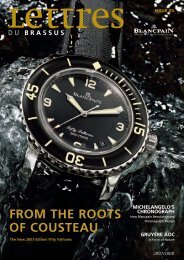IF ONLY WALLS COULD SPEAK - Blancpain
IF ONLY WALLS COULD SPEAK - Blancpain
IF ONLY WALLS COULD SPEAK - Blancpain
You also want an ePaper? Increase the reach of your titles
YUMPU automatically turns print PDFs into web optimized ePapers that Google loves.
After preaching his non-intervention<br />
beliefs for four years to a wide range<br />
of small high quality domains, Mounir decided<br />
to embark on his own venture. Through<br />
his consulting, he met domain owners who<br />
were single-mindedly dedicated to quality<br />
and to crafting wines of distinction. He then<br />
convinced these domains to sell him small<br />
fractions of their production. Sometimes this<br />
meant settling for but a single barrel—25<br />
cases—of a particular wine. Upon delivery of<br />
the wine in barrels, Mounir adheres to his<br />
non-intervention credo. In addition to abjuring<br />
fining, racking and filtering, he barrelages<br />
the reds and whites on 100% of their<br />
lees. Indeed, Mounir demands that his producers<br />
supply the wine with a large quantity<br />
of lees depending on the vintage. Lees are a<br />
source of CO2 which helps the wine age and<br />
in certain vintages like 2000 can bestow a<br />
slightly creamy quality. For the whites, a<br />
gentle stirring of the wine (called “batonnage”)<br />
is done three or four times a month.<br />
Mounir uses only the highest quality<br />
Seguin Moreau barrels with oak from the<br />
Jupilles forest. His attention to detail does<br />
not stop there. He insists upon fine grain in<br />
the oak and upon a slow toasting, varying in<br />
degree depending upon which wine will be<br />
aged in the barrel. Unusual today, when reuse<br />
of barrels for two or three vintages is<br />
common, 100% of his barrels are new.<br />
When it comes time to bottle the wines,<br />
Mounir does it the old-fashioned way, by<br />
gravity. By contrast, one large negotiant in<br />
Beaune, once pointed me with great pride<br />
to his newly installed system of pumps,<br />
meters and pipes with which he could automate<br />
the bottling process. Great wines are<br />
living things which evolve in the bottle. How<br />
58 | 59<br />
can such a delicate living thing be pushed<br />
through the vanes of a pump?<br />
In a further nod toward tradition, Mounir<br />
uses special heavy glass bottles with a very<br />
deep (or seen from the other side, high) indentation<br />
at the bottom (if you want to dazzle<br />
your friends with your mastery of wine terminology,<br />
the indentation is called a “punt”). Of<br />
course it is entertaining and practical to pour<br />
the wine with ones fingers firmly docked in<br />
the indentation, but there is another more<br />
substantive reason for bringing back this traditional<br />
bottle shape. The deep trough that is<br />
created becomes a good trap for sediment. As<br />
experienced burgundy collectors know, far<br />
from revealing a flaw in wine, the accumulation<br />
of sediment as the wine ages is the sign<br />
of a wine that is alive and evolving. The contrary<br />
is also true, wines without sediment<br />
generally get that way because the elements<br />
Mounir Saouma and<br />
Rotem Brakin







